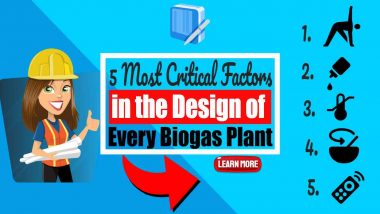The following article is an explanation of the options for Anaerobic Digestion Plant Digestate Enhancement, (Fibrous Biogas Digestate), which were reviewed by Pell Frischmann Consultants when they produced a report for WRAP in the UK (in December 2014), on the subject of Biogas Digestate Enhancement and Treatment Techniques, in 2012. It includes an updated background to the use of digestate in the UK and remains relevant today in 2021.
The reason for the report was to look at all the available options for fibrous digestate enhancement, with a view to achieving the most economic, if not the most profitable methods for fibrous digestate sale or disposal.
Background – Why Digestate Enhancement is Important
The use of biogas digesters for the treatment of sewage sludge with the benefit of generation of renewable energy is now well on its way to becoming the normal practice in the United Kingdom, and a number of other nations.

This perceived barrier has been removed by the results of research by the University of Southampton, but this example just goes to show how recently the research was all about whether this type of biogas digester would work reliably. Wind the clock forward to today, no more than 2 to 3 years afterwards, and many food waste AD plants have already been commissioned.
The end result has been that there has been very little research work done on digestate enhancement when compared with other aspects of biogas production.
However, 90 to 95% of the original feed material re-appears as digestate from the digester, and if the digester is running correctly the mass reduction is simply the mass of the biogas produced.
How any AD Plant handles digestate is therefore of huge significance to plant operation and to the economic viability of each plant.
With the undeniable increased popularity of waste digestion, the need to improve the available techniques for managing digestate, as a beneficial resource, and not just as a waste for disposal, is urgent.
The next frontier for Anaerobic Digestion will be the optimization of digestate by enhancement techniques and treatment. This will be essential to provide access to this sustainable natural fertilizer much more widely and to more profitable markets.
Not sure what digestate is? Watch our short video below and find out:
What is Digestate?
The material formed by anaerobically digesting biodegradable materials is known as digestate.
Digestate is a mixture of microbial biomass (generated during digestion) and undigested matter. The volume of digestate produced will be almost equal to the volume of feedstock, while the mass will normally be reduced by about 15%.
Digestate is an organic fertiliser since it contains all of the nitrogen, phosphorous, and potassium found in the original feedstock.
The following are typical digestate nutrient levels; however, the actual nutrient content will vary greatly depending on the type of feedstock processed (Chambers, 2011).
- Nitrogen levels range from 2.3 to 4.2 kg/tonne
- 0.2 – 1.5 kg/tonne phosphorus
- 1.3 – 5.2 kg/tonne potassium
(Source: NNFCC, 2012)
The link between the quality of the feedstock and the quality of the digestate must be taken into account.
Any pollutants in the feedstock will remain in the digestate since it will contain any material that has not biodegraded and turned into biogas during the process.
A high-quality, well-prepared feedstock will yield a high-quality digestate, whereas a low-quality feedstock will provide a low-quality digestate.
About the Study
The goal of the research was to find technologies and procedures that might be applied to digestate while also providing benefits. The choices were enumerated and studied, ranging from simple thickening/dewatering to the production of new products.
The study focused on digestate produced by anaerobic digestion methods, and it included the following topics (as quoted in the June 2013 issue of CIWM Magazine):
- Whether or not they are compliant with PAS 110 or the Anaerobic Digestion Quality Protocol (ADQP), both non-waste and waste-based digestates.
- Mixed-waste digestates as indicated by mechanical biological treatment (MBT) output.
- modified sludge digestates or co-digestates made from sewage sludge as a feedstock
- Sludge digestates (biosolids) are biosolids that are made entirely from sewage sludge.
The following are the main goals of the digestate enhancing procedures used in the study:
- boost the digestate's value
- to develop new markets for digestate-based products
- lessen reliance on land-based applications
- Ensure that digestate products have more secure and long-term outlets
- The facility's overall operating costs could be reduced.

Their study went on to “identify and assess potential digestate enhancement” and “a detailed desk-based literature search was undertaken, together with information requested from a number of anaerobic digestion organisations and interest groups, both within the UK and EU.”
They produced technical datasheets for each technology which are included in the published report which can be seen here:
A number of examples of the use of new technologies for biogas digestate enhancement have also been included in the report, and can be seen at the above link.
The digestate enhancement techniques considered by the Pell Frischmann team were grouped into the following categories of digestate processing methods:
- physical,
- biological,
- chemical and
- thermal.
Some of these techniques include a number of novel and emerging techniques for both liquid and fibrous Biogas Digestate as follows:
Physical on the Fibrous Biogas Digestate
Thickening by belt thickener equipment and by Centrifuge, dewatering by using a belt press, or centrifuge, or Dewatering using a hydro cell, or a Butcher press.
Finally, dewatering Fibrous Biogas Digestate by Electrokinetics, and Purification by Ultrafiltration and Reverse Osmosis.
Biological
Composting, Reed Beds, Biological Oxidation, Biofuel Production (Algae), Biofuel Production (liquor as process Bioethanol), Biofuel Production (hydrolysis of fibre to Bioethanol), or Microbial Fuel Cell.
Drying
Drying by rotary drying, belt drier, J-Vap technology, or solar evaporation (e.g. scraped surface heat exchangers)
Conversion
Conversion by incineration, gasification), wet air oxidation, or Pyrolysis
Chemical
Struvite precipitation, Ammonia recovery (Stripping + Scrubbing), Ammonia recovery (Membrane Contactor), or Ammonia recovery (Ion Exchange), and finally the option of Acidification.
Conclusion – Liquid and Fibrous Biogas Digestate
The above are all technologies that the study team identified that are either being applied to biogas digestate or have the potential to be applied to digestate.
The authors point out that all digestate treatment systems will be very site-specific, with no single system which will be optimal for all digester sites. Usually, the listed technologies will be used in combination, rather than individually.
In the study, it is made clear that, so far, in the UK the uptake of digestate enhancement technologies has been slow. It was not clear to the author of this article where the digestate is going in the absence of these enhancement techniques.
The main barriers in the UK, which are preventing the general adoption of these digestate improving methods are thought to probably include:
“the current cost of installation, as well as the operational costs associated with the technologies
the relatively low value of digestate products; and the associated cost of developing outlets or markets for digestate products.”
The research study concluded that presently there are a big variety of choices readily available for digestate treatment and recovery. Nevertheless, the most significant obstacle in the UK is the existing expense of setup, and the ongoing running costs, related to these innovative technological applications.
Eventually, the type of treatment employed to provide the most economic recovery path will certainly depend upon a number of factors, including whether it's a Liquid or a Fibrous Biogas Digestate.
Plus, the level of enhancement desired/ needed, and the available markets for digestate products and the accessibility of land-spreading markets.
Source: This article is based upon an article in the CIWM Magazine (June 2013 edition) by Pell Frischmann Consultants, who during 2012 completed an extensive desk-top study on digestate enhancement and treatment techniques for WRAP. [This article was first published in December 2014]






Hello everybody. Is fibre available for sale anywhere?